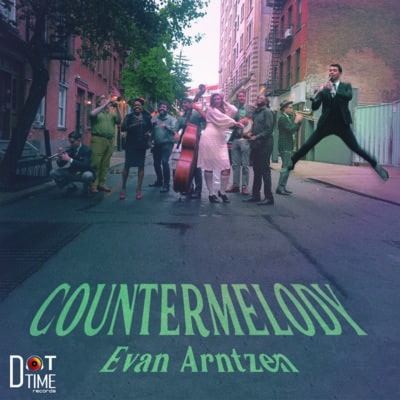Evan Arntzen Countermelody
Countermelody
Dot Time
Countermelody is the third album from multi-reedist, vocalist and bandleader Evan Arntzen. This is a throw-back record to the vintage sounds of New Orleans and Chicago in the early days of Black American music in the first half of the twentieth century, signaled in part by the premiere vocalist in the jazz vein specializing in such material, Dot Time label mate Catherine Russell (Cat). (Maria Muldaur and Rory Block do their part with vintage material on the blues side.) Arntzen’s superb reeds (plenty of clarinet) and vocals are supported by trombonist Charlie Halloran, trumpeters Jon-Erik Kellso and Mike Davis, guitarist and banjoist Arnt Arntzen, pianist Dalton Ridenhour, bassist Tal Ronen, and drummer Mark McLean.
Arntzen’s Dot Time Records debut features many of his own arrangements of early New Orleans and Chicago jazz compositions written by such luminaries as Kid Ory, King Oliver, Sidney Bechet and Bennie Moten. The release also features innovative compositions by Arntzen, Halloran and Kellso. Aside from thirteen hi-fidelity tracks, listeners will also be treated to tracks that were recorded to wax cylinder, a medium that predates when much of this music was composed. Producer Scout Opatut notes “the wax cylinder recordings were made possible by the genius Colin Hancock, who engineered them with his Edison phonograph. Everything you hear in those songs was done acoustically, without any electricity whatsoever.”
The album begins with Arntzen’s arrangement of the Kid Ory classic “Muskrat Ramble.” The jubilant energy is palpable from the very first notes and uplifted even further by Cat’s powerful and soulful refrains. It’s a tune this writer heard played often too as a set opener by the late Roy Eldridge’s combo on many a night at the since shuttered Jimmy Ryan’s on 52nd St. in NYC. The band delivers the instrumental “18th Street Strut” in jubilant fashion, showcasing the talents of each member, yet here as in many moments throughout the album it’s the interplay of the leader’s soaring clarinet offset by Halloran’s trombone that is simply arresting. “Camp Meeting Blues” begins with Ridenhour’s piano and quickly morphs to a mid-tempo steady groove with marvelous turns from Halloran and the leader as the rhythm section comps. Arntzen’s vocals soar on the Sidney Bechet popularized “Georgia Cabin,” seemingly the first-ever recording of this composition with its lyrics intact. Arntzen notes that he learned the lyrics from his 93-year-old grandfather Lloyd Arntzen (a celebrated clarinet player in his own right, who is still performing to this day). While the song is well-known as an instrumental, Evan’s grandfather credits Mary Karoley for writing the lyrics (she is indeed listed as a co-composer of the song).
“Put’ Em Down Blues” is a swinging rouser, in the classically old-time style, led by banjo, clarinet, and before Ridenhour takes a brief ragtime solo, converses with Arnt’s banjo, and leaves enough room for the others to chime in. “When Erastus Plays His Old Kazoo” is similar in feel, taken at a less frenzied tempo, with per the album title, plenty of counterpoint. This element shines even more brightly on the brief, more complex ever-tight “Smiles.” The ensemble welcomes back Cat for a warm take of “If You Were Mine,” the Billie Holiday classic.
The classic “Down By the Riverside” is relatively restrained, spiced with emotive takes from the trumpeters. “Alvita,” another tour-de-force for trombones and trumpets and one of the leader’s most potently articulated solos, has some Calypso strains, evoking the early Crescent City sound. “Counter Intuitive” begins with Ronen and McLean setting up ensemble lines and keening solos from the leader, meandering into some odd “snake charmer” lines, the plunger trombone, and muted trumpet in a looser, more explorative style than the others. The group brings an exceptional intensity to Benny Green’s “Bu’s March” in which Ridenhour is featured with a powerful solo. Of course, Green wrote this song in honor of his former mentor and bandleader Art Blakey, and the vigor of the Jazz Messengers is conjured in Arntzen’s new, 3-horn arrangement. The sole original composition by Arntzen, “Solitarity”, is a moving comment on our recent shared solitude. The piece begins with Arntzen’s solo clarinet refrains, eventually ending with a raucous second-line ensemble.
Aside from the two blues artists mentioned, there are but a handful of artists and groups performing this vintage music today, Catherine Russell’s band and Evan Arntzen’s unit which displays an impeccable command of the material, adding plenty of their own flourishes, a mix of sheer talent and unbridled fun.
– Jim Hynes
Buy Us a Cup of Coffee!
Join the movement in supporting Making a Scene, the premier independent resource for both emerging musicians and the dedicated fans who champion them.
We showcase this vibrant community that celebrates the raw talent and creative spirit driving the music industry forward. From insightful articles and in-depth interviews to exclusive content and insider tips, Making a Scene empowers artists to thrive and fans to discover their next favorite sound.
Together, let’s amplify the voices of independent musicians and forge unforgettable connections through the power of music
Make a one-time donation
Make a monthly donation
Make a yearly donation
Buy us a cup of Coffee!
Or enter a custom amount
Your contribution is appreciated.
Your contribution is appreciated.
Your contribution is appreciated.
DonateDonate monthlyDonate yearlyYou can donate directly through Paypal!
Subscribe to Our Newsletter
 |  Spotify |  Deezer | Breaker |
 Pocket Cast |  Radio Public |  Stitcher |  TuneIn |
 IHeart Radio |  Mixcloud |  PlayerFM |  Amazon |
 Jiosaavn |  Gaana | Vurbl |  Audius |
Reason.Fm | |||
Find our Podcasts on these outlets
Discover more from Making A Scene!
Subscribe to get the latest posts sent to your email.














































